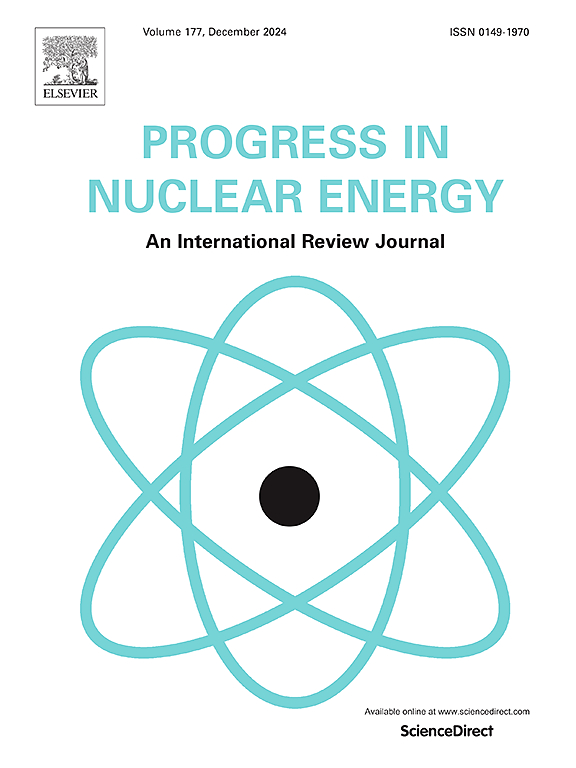Optimizing the local-scale turbulence-induced dispersion of LAPMOD at a Chinese nuclear power plant with heterogeneous topography and irregular building layouts
IF 3.3
3区 工程技术
Q1 NUCLEAR SCIENCE & TECHNOLOGY
引用次数: 0
Abstract
This study proposes a composite correction scheme to address the inadequate turbulence-induced dispersion of the Lagrangian Particle Model (LAPMOD) at a nuclear power plant site with complex terrains and irregular buildings. The proposed scheme combines both background and local optimization of the turbulence intensity, which are overall lower bound settings and local correction in building zones. The feasibility of the correction is comprehensively assessed by comparing multiple LAPMOD's simulations with measurements from two wind tunnel experiments of a Chinese nuclear power plant. Furthermore, a comprehensive sensitivity analysis is conducted to optimize the mixing length parameterization in the surface layer of the proposed scheme. The results show that the correction scheme significantly enhances the agreement between simulations and measurements, with respect to both spatial plume coverage and quantitative metrics. It effectively mitigates long-range overestimations in the plume center, reduces deviations at axial sites, and accurately reproduces the vertical concentration profile at the main mountain and building-area boundary. The quantitative metrics confirm the excellent performance of the correction scheme, achieving the acceptance criteria of all four quantitative statistical metrics. The sensitivity analysis reveals that the optimal mixing length is the ensemble mean of two classic schemes, enhancing applicability of the proposed scheme in practice.
中国某核电站非均匀地形和不规则建筑布局下LAPMOD局部尺度湍流扩散优化
针对拉格朗日粒子模型(LAPMOD)在复杂地形和不规则建筑条件下的紊流色散不足问题,提出了一种复合校正方案。该方案结合了湍流强度的背景优化和局部优化,即建筑区域的整体下界设置和局部校正。通过将多个LAPMOD模拟结果与中国某核电站两次风洞实验结果进行比较,综合评价了修正的可行性。此外,对该方案进行了综合灵敏度分析,优化了表层混合长度参数化。结果表明,修正方案在空间羽流覆盖和定量指标方面显著提高了模拟与测量的一致性。它有效地减轻了烟羽中心的远程高估,减少了轴向位置的偏差,并准确地再现了主要山区和建筑物区域边界的垂直浓度剖面。定量指标证实了校正方案的优异性能,达到了所有四个定量统计指标的可接受标准。灵敏度分析表明,最优混合长度为两种经典方案的集合平均值,增强了方案在实际应用中的适用性。
本文章由计算机程序翻译,如有差异,请以英文原文为准。
求助全文
约1分钟内获得全文
求助全文
来源期刊

Progress in Nuclear Energy
工程技术-核科学技术
CiteScore
5.30
自引率
14.80%
发文量
331
审稿时长
3.5 months
期刊介绍:
Progress in Nuclear Energy is an international review journal covering all aspects of nuclear science and engineering. In keeping with the maturity of nuclear power, articles on safety, siting and environmental problems are encouraged, as are those associated with economics and fuel management. However, basic physics and engineering will remain an important aspect of the editorial policy. Articles published are either of a review nature or present new material in more depth. They are aimed at researchers and technically-oriented managers working in the nuclear energy field.
Please note the following:
1) PNE seeks high quality research papers which are medium to long in length. Short research papers should be submitted to the journal Annals in Nuclear Energy.
2) PNE reserves the right to reject papers which are based solely on routine application of computer codes used to produce reactor designs or explain existing reactor phenomena. Such papers, although worthy, are best left as laboratory reports whereas Progress in Nuclear Energy seeks papers of originality, which are archival in nature, in the fields of mathematical and experimental nuclear technology, including fission, fusion (blanket physics, radiation damage), safety, materials aspects, economics, etc.
3) Review papers, which may occasionally be invited, are particularly sought by the journal in these fields.
 求助内容:
求助内容: 应助结果提醒方式:
应助结果提醒方式:


